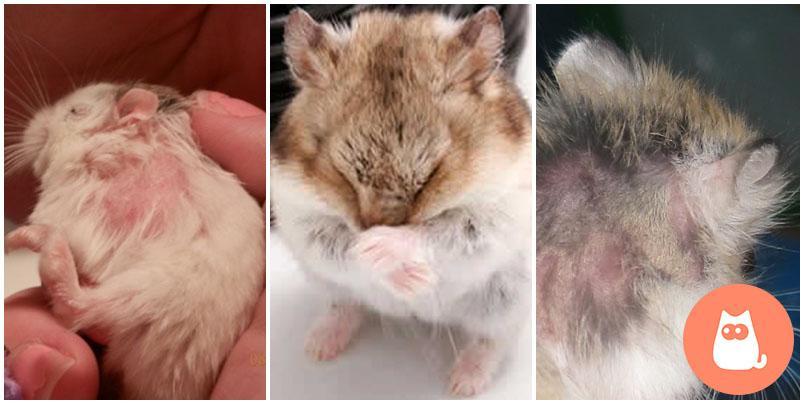How to Get Rid of Hamster Mites - Symptoms, Treatment and Home Remedies



See files for Hamsters
Mites are hematophagous ectoparasites, part of a subclass of tiny sized arachnids. They are ectoparasites because they live off of the outside of their host and are hematophagous because they feed on said host's blood for sustenance. They are recognized as one of the world's most common allergens, i.e. they can cause allergic reactions. Human beings can be affected by mites, some of which are so small they travel in the air. However, companion animals such as the hamster can also have problems due to mites.
At AnimalWised we discuss how to get rid of hamster mites by looking at the symptoms of an infestation and what to do about it. Some of the treatment method include home remedies which won't require you to spend a lot of money on treatment and will have a minimal negative impact on the hamster.
Why does my hamster have mites?
When we think of mites on hamsters, we would likely think they are always negative. However, a certain amount of mites on a hamster's fur is relatively normal. The problem is when these ectoparasites create an overpopulation of mites, leading to negative health consequences. Mite infestations are one of the most common diseases in hamsters and getting rid of them requires special attention from their caregivers.
In general, there could be a few different factors in an infestation of mites in a hamster. The main causes of mites on hamsters include:
- Problems with their hygiene routine
- Weakness of the immune system
- Inadequate nutrition
- Poor upkeep of their cage and the objects therein
- Exposure to disease
However, it is also important to know that stress can be related to underlying health problems. These can lead to hair loss (alopecia), bacterial infections or skin problems. These may be concurrent or related to mites, but not necessarily the root cause.
Hamsters which share their home with other hamsters can be infected with mites or other ectoparasites (such as fleas and ticks). This is usually through direct contact. Mites can be passed on to other pets such as dogs and cats. Some people may also be concerned about hamster mites on humans. Unfortunately, hamster mites can be passed on to humans, so you need to be extra careful when handling an infested rodent.
You should also note that not all hamster breeds should live together. Dwarf hamsters can often get along well, although males in mating partners should be removed from the cage once a litter is born. Syrian hamsters, however, are very territorial and will often fight to the death. For this reason, they should be allowed to live alone.
Symptoms of mites on hamsters
The first symptoms of a mite infestation on hamsters is usually an intense itching. This will cause the hamster to scratch itself frequently, leading to inflamed and reddened skin. As the skin becomes damaged, this can lead to loss of fur and can be very stressful for the hamster. Once the hair has fallen out, the skin will likely develop scabs and legions on their skin. Eczema can also be found, presenting with flaky dry skin. You may see some fluid or even blood develop on the damaged skin.
Ear mites are the most common type of mite in hamsters. They can often travel to other parts of the hamster once their numbers become too many. These mites often look like little black dots moving along their fur. You can also sometimes see tiny red mites on hamster skin as the mites are not always the same color.
The itching and scratching caused by hamster mites will affect their overall behavior. They will usually be more hyperactive and nervous than usual. They may be unable to walk in their cage as usual and can develop other behavioral problems such as anxiety and stress. In the even that hamster mites are not treated properly, it can lead to the development of scabies.
As a recap, the most common symptoms of hamster mites are:
- Intense itching
- Inflamed skin
- Reddened skin
- Dry, scaly skin
- Excessive scratching
- Lesions on the skin
- Hair loss
- Baldness
- Skin infection
Blisters can also form in untreated cases of hamster mites. These may be more likely to appear in areas such as the nose, genitals, ears and extremities.

Treatment for hamster mites
But what do we do if a hamster has mites? When recognizing any of the symptoms mentioned above, or if you detect any particular anomaly with the hamster's behavior, you should take them to a vet specialized in exotic animals. Remember that hamster mites reproduce very quickly, so the infestations and symptoms will worsen just as speedily. This puts the overall health of the hamster at risk.
At the clinic, the veterinarian will perform fundamental diagnostic tests to choose an effective and appropriate treatment. Generally, acaracides such as ivermectin will be used. An acaracide is a medication which is designed to kill mites. This may be injected over the course of several weeks until the infestation is halted. If there are underlying infections caused by the infestation, the vet will also evaluate the possibility of treatment with antibiotics.
The complete sanitization of the hamster's environment will be an essential aspect of the mite treatment. These include any objects in the cage, accessories, toys, drinking bottles and food bowls. First, you will need to wash all the objects in the cage using a neutral soap and hot water. Then you can apply some insecticide/acaracide product prescribed by the veterinarian. Do not use traditional cleaners or corrosive products such as creolin or chlorine. These may aggravate the irritation of the skin and mucous membranes of the rodent.
If you have more than one hamster in the cage or any other animals in the home, you will have to examine them for any signs of infestation. If you do identify any anomaly, it will be essential for your to take them to the veterinary clinic also. Even if they do not show symptoms, you will need to separate an infested hamster from any other animals. Since hamster mites can infest humans, it is important to protect your hair and skin as well as wash thoroughly after any interaction with the hamster or its things.
Homemade remedies for hamster mites
There is no substitute for taking a mite infested hamster to the vet to treat mites. They will need to ensure mites are indeed the cause of their problem and will be able to handle any concurrent medical problems. However, there are also some home remedies which can be used in conjunction with this treatment. Just ensure you check with the vet to ensure they won't interfere with the main treatment. These natural remedies for hamster mites include:
- Garlic: has antiviral, insecticidal, antibacterial and antiparasitic properties. Although it is a toxin in high concentrations, its moderate intake or application might help to keep our pets free of internal and external parasites. To combat mites in hamsters, you can apply the garlic topically. You do this by making a maceration of olive oil and garlic. Put a few cloves of garlic in a cup of olive oil. Heat the oil until it is warm, but not until it starts to cook the garlic. Let it rest for a day and then use the infused oil on the skin of the hamster. A few drops will do. Garlic contains allicin, something a report from 2009 claims is one of the most powerful antioxidants in nature[1].
- Vitamin E: another one of the world's most powerful antioxidants is vitamin E. It can work as a natural remedy to combat hamster mites. You can buy vitamin E capsules in pharmacies which are suitable for dermatological use. Dilute one capsule in a base of neutral oil such as olive oil. Add a few drops to the skin every other day and wipe with a sterile gauze (being careful not to damage any irritated skin).
- Tea tree oil: this is believed to be one of the most effective home remedies for hamster mites. We should do something similar to the vitamin E capsule. Add about 20 drops of tea tree oil to 100 ml of a neutral oil such as olive oil, almond oil, coconut oil, etc. In preventive treatments, we can apply this solution once or twice a week. If the hamster has a mite infestation, we can apply it daily until the symptoms subside.

How to prevent hamster mites
To prevent mites from affecting the health of your rodents, it is essential to follow the basic guidelines to strengthen the immune system of hamsters. This will help to avoid imbalances in the hamster's body and prevent mite infestation. They will also help to improve the hamster's overall quality of life.
- Offer a complete and balanced feed to your hamster. This needs to cover all of their nutritional requirements. You can learn a little more about what hamsters eat if you want to know what this entails.
- Provide them with adequate preventive medicine. This should include visits to the veterinarian every 6 to 12 months as well as providing basic care for the hamster.
- Enrich their cage by providing toys, accessories and walkways to allow them the chance to exercise both body and mind. This will also help alleviate symptoms of stress and boredom which can indirectly lead to mites.
- Maintain the optimal hygiene of the cage. Keep the cage in optimal light with fresh air.
- If you have other pets, follow the same guidelines to preserve their good health and avoid contagion by ectoparasites or endoparasites.

This article is purely informative. AnimalWised does not have the authority to prescribe any veterinary treatment or create a diagnosis. We invite you to take your pet to the veterinarian if they are suffering from any condition or pain.
If you want to read similar articles to How to Get Rid of Hamster Mites - Symptoms, Treatment and Home Remedies, we recommend you visit our Parasitic diseases category.







